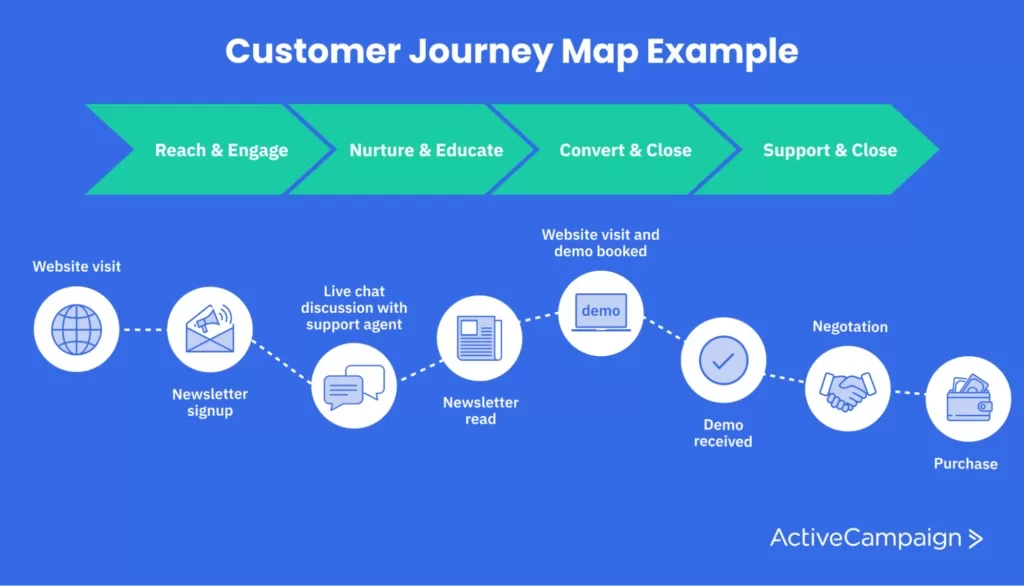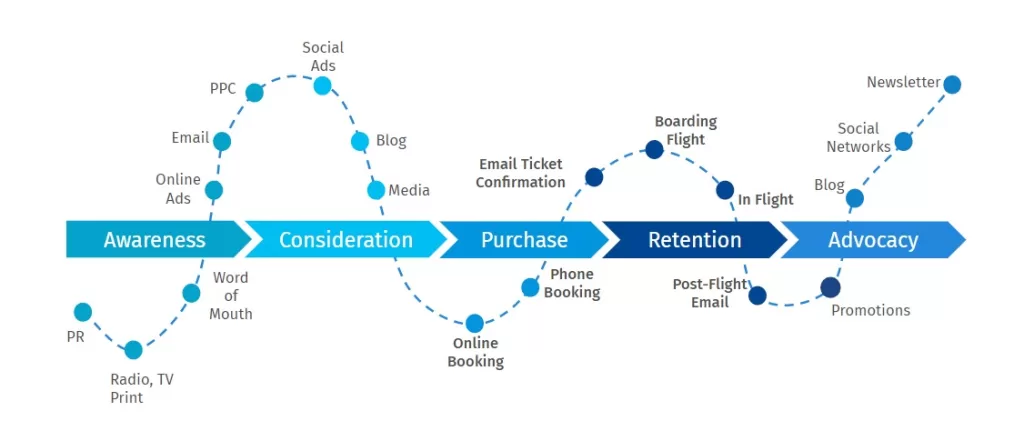Visual depictions of a client’s experience are called customer journey maps. It contributes to a better knowledge of the requirements of potential clients at each stage of the purchasing process as well as the forces that encourage and restrain them.
Why do you need a customer journey map?
Customer experience consultant Kerry Bodine outlined the goal of customer journey maps.
The objective of a customer journey map is to obtain a comprehensive understanding of what the client is experiencing from their point of view and what it’s like for them on a personal, human level.
What does a great customer journey map look like?
Every route map is different. Depending on the sort of business (i.e., product or service), the design will change.
Customer journey maps are known as “experience maps,” according to a company Capital One acquired called Adaptive Path. Their depictions:
1. Show the customer’s progression through each stage of the encounter.
2. Describe each stage from the perspective of the consumer.
The Adaptive Path team builds a touchpoint inventory after conducting qualitative and quantitative research:


Starting from there, they develop a “lens” based on the client profiles they have developed through which to view the trip. Each character can produce a map that can be consulted while deciding how to move forward.
A customer journey map identifies the places in the customer’s journey to purchase and beyond when they get frustrated or stalled. It is a graphic representation that integrates user and persona information.
The customer journey may be difficult to map without data-driven personas.
What motivates your clients? What are their demands, objections, and worries? The first stage of communication is to identify your audience. It is not enough to rely on anecdotes or educated predictions. To construct effective personas, data is necessary.
The most prosperous companies of today mine their data extensively to develop personalities. Once you’ve developed your personas, you can use that data in conjunction with a thorough analysis of website user behavior. Your map of the customer journey will be the outcome.
How to Create a Customer Journey Map in 5 Easy Steps
While journey maps can encompass all interactions with a company, this section will show you how to create one to improve your website.
Step 1: Define the behavioral stages.


Depending on what you sell, customers may navigate your site through several stages. While a B2B SaaS company selling to the Fortune 100 may have multiple phase, a B2C e-commerce company may only have a few distinct phases.
Your personas ought to give you a clear picture of the path that customers travel from the moment they land to the moment they make a purchase and beyond.
Choosing which interactions go into which phases is the next step.
Step 2: Align customer goals with each stage.
This is arguably the most important and, in some cases, the trickiest stage in creating a customer journey map.
What do buyers expect their purchases to accomplish?
What do customers aim to achieve at each stage of the behavioral cycle? You can obtain the information from a variety of data sources, including:
results of surveys.
user research.
transcripts of interviews.
Emails from customer support or help transcripts.
Then, you can determine whether your website achieves each of those goals.Then you may assess whether each of those objectives is met by your website.
Step 3: Outline your touchpoints.
Consider touchpoints to be locations where users connect with your website and you help them accomplish their goals. These touchpoints will be grouped based on where your customer is in their journey.
For shops, a product description page may be a typical touchpoint; for service providers, it might be anything from a pricing page to a contact form.
Two Google Analytics reports can be used to pinpoint user journey touchpoints:
- Behavior Flow report.
- Goal flow report
- Behavior Flow report
You may observe how visitors move between pages or events using the Behavior Flow report. This might highlight or explain to you where your users are having trouble finding the information they require.
You can categorize traffic by any dimension by hovering your mouse over specific points in the flow.
- Goal Flow report
You may determine whether users are completing a goal of your choosing through a funnel using the Goal Flow report.
You’ll be able to identify if users—or a subset of them—are abruptly abandoning in the middle of reaching the destination or if your traffic is looping around.
Step 4: Evaluate if your consumers achieve their goals successfully or not
Here, you compare the data you’ve gathered to the ease with which your customers execute their jobs.
Think about the following types of queries:
Where are the choke points?
Do many customers leave their shopping carts empty on the checkout page?
Do visitors to your opt-in download page abandon the form after viewing it?
The in-depth Google Analytics reports you’ve gathered will show where problems are. are.Where issues occur will be revealed by the information-rich Google Analytics reports you’ve collected. Your current qualitative data and the research you performed to develop your personas should help you comprehend the root causes of the problems.
Analyze the behavior—or lack thereof—of your customers. How well are their needs met at each point of contact and each stage?
Step 5: Provide suggestions for improvements.
Choose which pages or touch points should be handled first before anything else. Based on how easy and inexpensive it is to update a page, it can be ranked. Choosing what to test is the next step.
For instance, if research shows that customers worry about being forced into a particular plan after signing up, modifying the language on the appropriate page may allay their worries.
How to Visualize a Customer Journey Map
Spreadsheets may not be appealing, but they are excellent for data organization. Your client journey map does not have to be intricate or visually appealing.
Remember: that it is a tool to help you learn how users interact with your site, where they get stuck, and how to address problem areas.
It’s crucial to realize that customer connection with your website or brand doesn’t follow a straightforward routine. Getting individuals to proceed from point A to point B without abandoning the journey or skipping a step is not always simple. The factors that can influence this trip include customer pain areas, feelings, and your company’s touchpoints and procedures, to name a few.
However, making an effort to understand as much as you can about the objectives of your customers and how they use your website could go a long way in ensuring their satisfaction. It will also support the growth of your company.
Customer-focused companies consult with us because they are aware of this. Are you trying to make the customer’s journey as efficient as possible or are you looking into a new market to meet a customer’s unmet needs?
Let us assist you in developing an efficient customer journey map that will allow you to comprehend the experiences of your consumers and pleasure them throughout the entire buying process. Invite Atarodo to a discovery call.



